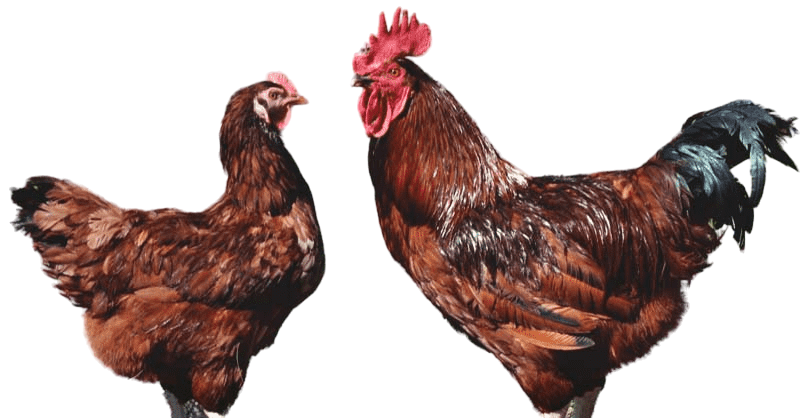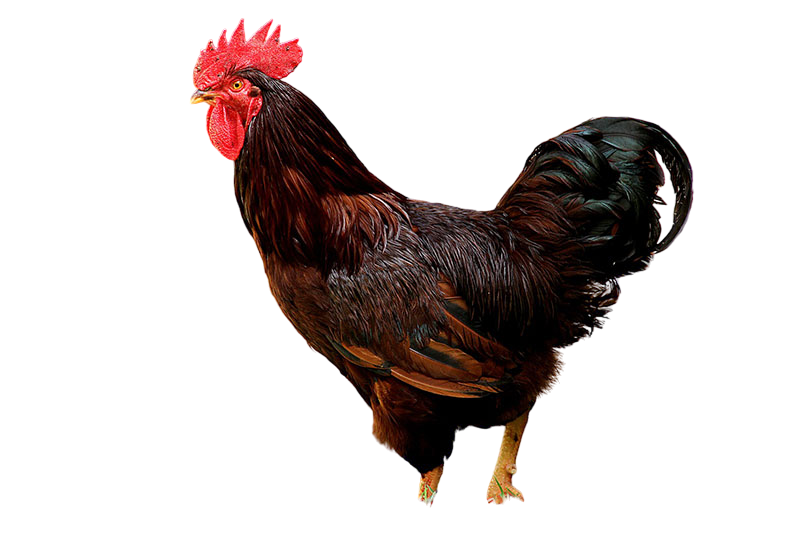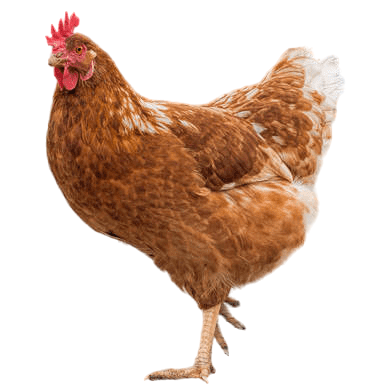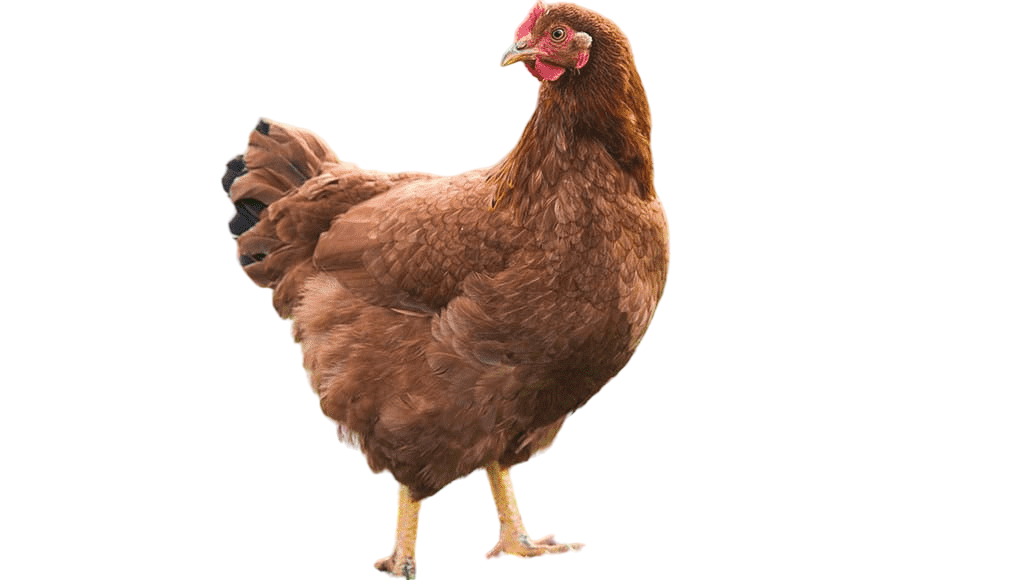Rhode Island Red
Breed Overview
Description
The Rhode Island Red is a dual-purpose breed, valued for both its meat quality and egg production. It is known for its robustness, adaptability, and consistent performance in various environments.
Appearance
Size
Rhode Island Reds are medium to large-sized birds. Hens typically weigh between 6 to 8 pounds (2.7 to 3.6 kg), while roosters are slightly heavier, weighing around 8 to 10 pounds (3.6 to 4.5 kg).
Feathering
The breed is most commonly recognized by its rich red plumage. The feathers are usually dark red to mahogany, with some variations in shade. Their feathering is dense and provides good insulation.
Comb and Wattles
Rhode Island Reds have a single comb that is medium-sized and red. Their wattles are also red and complement the comb. The comb and wattles help with heat regulation.
Legs
Their legs are usually yellow or reddish, in keeping with their overall colouring.
Origin
The Rhode Island Red was developed in the late 19th century in Rhode Island, USA. It was created by crossbreeding various breeds, including the Malay and the Shanghais, to produce a bird that excelled in both egg production and meat quality. The breed quickly gained popularity due to its adaptability and hardiness.
History
The Rhode Island Red was developed by local farmers in Rhode Island who aimed to create a bird that would thrive in various conditions and provide both meat and eggs. By selectively breeding chickens with desirable traits, they created a breed that was resilient and productive. The breed was officially recognized in the early 20th century and has since become one of the most beloved and widely kept poultry breeds in the United States and around the world.
Care
Feeding
Rhode Island Reds require a balanced diet to support their egg production and overall health. They thrive on commercial layer feed that provides essential nutrients, including proteins, calcium, and vitamins. Fresh, clean water must always be available to keep them hydrated and to support their egg-laying capabilities.
Housing
Rhode Island Reds are adaptable to various housing systems. They can thrive in traditional coops, chicken runs, or free-range environments. Their housing should be clean, dry, and well-ventilated to prevent health issues. Providing adequate space and protection from harsh weather is essential for their well-being.
Health
Maintaining the health of Rhode Island Reds involves regular health checks, vaccinations, and biosecurity measures. They are generally hardy birds but can be susceptible to common poultry diseases if not properly managed. Good hygiene practices, including regular cleaning of their housing and proper nutrition, help prevent health problems.
Behaviour
Characteristics
Rhode Island Reds are known for their friendly and calm temperament. They are generally easy to handle and manage, making them suitable for both backyard flocks and larger poultry operations. Their hardy nature and resilience to various environmental conditions make them a popular choice among poultry keepers.
Egg Production
Egg Quantity:
Rhode Island Reds are prolific layers and typically produce between 250 to 300 eggs per year. This high production rate makes them one of the more productive chicken breeds for egg farming.
They lay eggs fairly consistently, usually laying an egg almost every day. The production can be influenced by factors like age, health, and environmental conditions.
Egg Size and Color:
The eggs laid by Rhode Island Reds are generally medium to large in size. This size is relatively standard among commercial laying breeds, making them desirable for both home consumption and the market.
Rhode Island Reds produce brown eggs. The shell colour can vary from light tan to darker brown, though it is typically a uniform shade. The exact colour can depend on the individual hen and her diet.
Egg Production Cycle:
Rhode Island Red hens usually begin laying eggs around 5 to 6 months of age. This onset can vary slightly depending on factors like diet, housing, and overall health.
They typically reach their peak production around 6 to 8 months of age. During this time, they can lay eggs almost daily.
Egg production may gradually decline after about 2 to 3 years of age. While they continue to lay eggs, the frequency and consistency might not be as high as during their peak.
Seasonal Variation:
Egg production can decrease during the winter due to reduced daylight hours. Rhode Island Reds, like many other breeds, are influenced by the length of the day. Lower light levels can lead to a drop in egg production.
To mitigate the drop in production during winter, many poultry keepers use artificial lighting to extend the day length, which helps maintain egg production levels. A common practice is to provide 14 to 16 hours of light per day to encourage continued laying.
Environmental Factors:
Rhode Island Reds are adaptable to various housing conditions, but they thrive best in environments where they have enough space and good ventilation. Overcrowding can lead to stress and reduced egg production.
They are known for their hardiness and can tolerate a range of temperatures. However, extreme heat or cold can affect their laying. Adequate shelter and insulation help protect them from severe weather.
A balanced diet is crucial for optimal egg production. Rhode Island Reds need a high-quality layer feed that provides the necessary proteins, calcium, and other nutrients. Supplementing their diet with calcium (like crushed oyster shells) can help maintain strong eggshells.
Moulting Period:
Rhode Island Reds, like all chickens, undergo a moulting process, where they shed and regrow feathers. This typically happens once a year, usually in the late summer or early autumn.
During moulting, egg production often slows down or temporarily stops. The process of regrowing feathers demands significant energy, which diverts resources away from egg production. After moulting, once the feathers are fully regrown, egg production usually resumes, though there might be a period of adjustment as the hens return to peak laying conditions.
Foraging
They are active foragers and enjoy exploring their surroundings. They will scratch and peck at the ground in search of food if given the opportunity. Allowing them to free-range can help keep them engaged and provide additional food sources.
Socialization
Rhode Island Reds are social birds that get along well with other chickens. They are generally non-aggressive and have a harmonious presence in the flock, which contributes to a peaceful flock environment.
In summary, the Rhode Island Red is a versatile and hardy breed known for its excellent egg production and meat quality. With its rich red plumage, friendly demeanor, and adaptability to various conditions, it is a favorite among poultry enthusiasts and commercial producers alike. The breed’s resilience and consistent performance make it a valuable addition to any flock.



